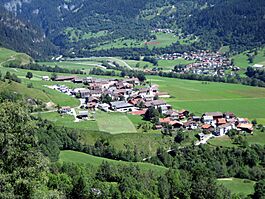Donat, Switzerland facts for kids
Quick facts for kids
Donat
|
||
|---|---|---|
 |
||
|
||
| Country | Switzerland | |
| Canton | Graubünden | |
| District | Viamala | |
| Area | ||
| • Total | 4.67 km2 (1.80 sq mi) | |
| Elevation | 1,043 m (3,422 ft) | |
| Population
(December 2019)
|
||
| • Total | 201 | |
| • Density | 43.04/km2 (111.5/sq mi) | |
| Postal code |
7433
|
|
| Localities | Donat, Patzen, Farden | |
| Surrounded by | Casti-Wergenstein, Clugin, Lohn, Mathon, Pignia, Zillis-Reischen | |
Donat is a small town in the Viamala Region of Graubünden, a canton in Switzerland. It used to be its own municipality.
On January 1, 2021, Donat joined with three other nearby towns: Casti-Wergenstein, Lohn, and Mathon. Together, they formed a new, larger municipality called Muntogna da Schons.
History of Donat
Donat is a very old place. It was first written about in the middle of the 12th century. Back then, it was called ad Anede. That means people have lived and worked in Donat for over 800 years!
Geography of Donat
Donat covers an area of about 4.7 square kilometers (1.8 square miles). A large part of this land, nearly 40%, is used for farming. Over half of the area, about 52%, is covered by forests.
A small portion, 2.6%, has buildings and roads where people live and travel. The remaining 5.6% includes natural features like rivers or mountains.
Donat is located on the lower Schamserberg, which is a hillside. It sits on the left bank of the Hinterrhein River. The town includes the main settlement of Donat and the areas of Pazen-Farden.
In 2003, the smaller towns of Donath and Patzen-Fardün officially merged. At that time, their names were changed back to their original Romansh forms. Donath became Donat, Patzen became Pazen, and Fardün became Farden. This change happened because most people in the combined area spoke Romansh.
Donat is a linear village. This means its buildings are spread out along a road or path. It has different sections like Curscheglias, Tarvisch, and Tscharviof.
People and Population
In 2019, Donat had a population of 201 people. About 5% of the people living in Donat in 2008 were from other countries. Over the last ten years, the number of people living in Donat has slightly decreased.
In 2000, more women lived in Donat than men. About 57% of the population was female, and 43% was male.
Here's a look at the age groups in Donat in 2000:
- 15% of the people were children aged 0 to 9 years old.
- 12% were between 10 and 14 years old.
- 5.3% were teenagers aged 15 to 19.
- About 8.3% were young adults between 20 and 29 years old.
- 15.8% were between 30 and 39 years old.
- 9.8% were between 40 and 49 years old.
- Another 9.8% were between 50 and 59 years old.
- About 8.3% were seniors aged 60 to 69.
- 7.5% were between 70 and 79 years old.
- Another 7.5% were between 80 and 89 years old.
- Only a very small number, 0.8%, were 90 years or older.
Most adults in Donat have a good education. About 78% of people aged 25-64 have finished high school or gone on to higher education, like university.
Donat has a very low unemployment rate, which means almost everyone who wants a job has one. In 2005, many people worked in farming. A smaller number worked in services, like shops or offices.
The population of Donat has changed over time:
| Year | Population |
|---|---|
| 1835 | 167 |
| 1850 | 188 |
| 1900 | 128 |
| 1950 | 118 |
| 2000 | 133 |
Languages Spoken
Donat is special because people speak two main languages there: Romansh and German. In 2000, slightly more people spoke Romansh (53.8%) than German (41.1%). A smaller group of people also spoke Serbo-Croatian (4.1%).
Romansh is a very old language that is only spoken in parts of Switzerland. It's one of Switzerland's four national languages.
See also
- In Spanish: Donat para niños




